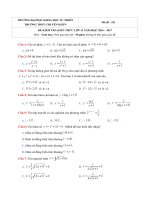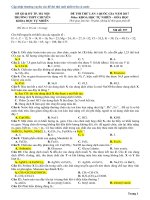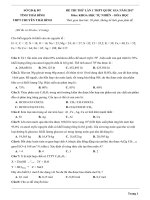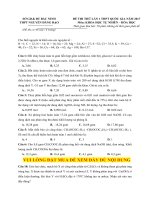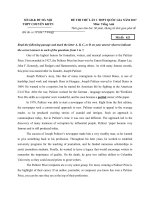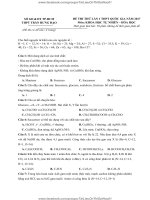- Trang chủ >>
- THPT Quốc Gia >>
- Toán
6 thpt hong ha hn nam 2017 lan 1 co loi giai
Bạn đang xem bản rút gọn của tài liệu. Xem và tải ngay bản đầy đủ của tài liệu tại đây (197.33 KB, 9 trang )
www.facebook.com/groups/TaiLieuOnThiDaiHoc01
SỞ GD ĐT HÀ NỘI
THPT CHUYÊN HỒNG HÀ
ĐỀ THI THỬ LẦN 1 THPT QUỐC GIA NĂM 2017
Môn: TIẾNG ANH
Thời gian làm bài: 60 phút, không kể thời gian phát đề
oc
ai
H
Mark the letter A, B, C, or D on your answer sheet to indicate the word whose underlined
part differs from the other three in pronunciation in each of the following questions.
Question 1: A. laughed
B. sacrificed
C. cooked
D. explained
Question 2: A. airports
B. ways
C. questions
D. pictures
01
(Đề thi có 50 câu / 4 trang)
nT
hi
D
Mark the letter A, B, C, or D on your answer sheet to indicate the word that differs from the
other three in the position of primary stress in each of the following questions.
Question 3: A. verbal
B. signal
C. common
D. attract
Question 4: A. historian
B. certificate
C. academic
D. curriculum
om
/g
ro
up
s/
Ta
iL
ie
uO
Mark the letter A, B, C, or D on your answer sheet to indicate the underlined part that needs
correction in each of the following questions.
Question 5: Because the highway system was built 40 years ago , most of the roads now need to
A
B
C
repair.
D
Question 6: Pointing in someone is usually considered impolite but it is acceptable when a
A
B
C
teacher wants to get someone’s attention in class.
D
Question 7: If a student takes a course on Computer Science, it will take him four years doing the
A
B
C
D
course.
w
w
w
.fa
ce
bo
ok
.c
Mark the letter A, B, C, or D on your answer sheet to indicate the correct answer to each of the
following questions.
Question 8: Many applicants find a job interview__________if they are not well-prepared for it.
A. impressive
B. stressful
C. threatening
D. time-consuming
Question 9: He managed to win the race__________hurting his foot before the race.
A. in spite of
B. despite of
C. although
D. because of
Question 10: Hardly__________when the argument began.
A. when he arrived
B. he had arrived
C. than he arrived
D. had he arrived
Question 11: Housework is less tiring and boring thanks to the invention of__________devices.
A. environment-friendly
B. time-consuming
C. labor-saving
D. pollution-free
Question 12: By the end of the 21st century, scientists__________a cure for the common cold.
A. will find
B. will have found
C. will be finding
D. will have been finding
Question 13: Last Sunday was __________that we took a drive in the country.
A. so beautiful day
B. such a beautiful day
C. so a beautiful day
D. such beautiful day
Trang 1
www.facebook.com/groups/TaiLieuOnThiDaiHoc01
oc
ai
H
hi
D
Question 14: Widespread forest destruction__________in this particular area.
A. must have seen B. ought to see
C. could have seen D. can be seen
Question 15: The greater the demand, __________the price.
A. the highest
B. the high
C. higher
D. the higher
Question 16: After twenty years collecting stamps, Mike__________interested in them.
A. is not longer
B. no longer
C. no longer is
D. is no longer
Question 17: He asked me __________.
A. since when I’m waiting
B. how long I have been waiting
C. how long I had been waiting
D. since when I waited
Question 18: __________ten minutes earlier, you would have got a better seat.
A. Had you arrived
B. If you arrived
C. Were you arrived
D. If you hadn’t arrived
Question 19: He still hasn’t really__________the death of his mother.
A. recovered
B. got over
C. cured
D. treated
01
www.facebook.com/groups/TaiLieuOnThiDaiHoc01
up
s/
Ta
iL
ie
uO
nT
Mark the letter A, B, C, or D on your answer sheet to indicate the most suitable response to complete
each of the following exchanges.
Question 20: - Charles : “ Do you fancy going to a movie this evening ? ”
- Lisa:
“ ____________”
A. I’m sorry. I don’t know that.
B. Not at all. Go ahead.
C. Not so bad. And you ?
D. That would be nice.
Question 21: - John : “ What kind of job would you like ?
- Tim : “ __________ “
A. All of them are
B. I heard it was very good
C. Anything to do with computers
D. Anytime after next week
ok
.c
om
/g
ro
Mark the letter A, B, C, or D on your answer sheet to indicate the word(s) CLOSEST in meaning to
the underlined word(s) in each of the following questions.
Question 22: He sounded panic-stricken on the phone.
A. terrified
B. troubled
C. happy
D. disappointed
Question 23: Few businesses are flourishing in the present economic climate.
A. taking off
B. setting up
C. growing well
D. closing down
w
.fa
ce
bo
Mark the letter A, B, C, or D on your answer sheet to indicate the word(s) OPPOSITE in meaning to
the underlined word(s) in each of the following questions.
Question 24: Although it’s a long day for us, we feel we are contented with what we do.
A. interested
B. dissatisfied
C. excited
D. shocked
Question 25: I can’t stand people who treat animals cruelly.
A. gently
B. cleverly
C. reasonably
D. brutally
w
w
Mark the letter A, B, C, or D on your answer sheet to indicate the sentence that is closest in meaning
to each of the following questions.
Question 26: It is possible that the fire in the ship was started by a bomb.
A. They say that a bomb started the fire in the ship.
B. The fire in the ship might have been started by a bomb.
C. It shall be said the fire in the ship had been started by a bomb.
D. The fire in the ship is known to have been started by a bomb.
Trang 2
www.facebook.com/groups/TaiLieuOnThiDaiHoc01
www.facebook.com/groups/TaiLieuOnThiDaiHoc01
ai
H
oc
01
Question 27: Neil always forgets his wife’s birthday.
A. At no time Neil remembers his wife’s birthday.
B. Neil never remembers his wife’s birthday.
C. Neil sometimes remembers his wife’s birthday.
D. Neil remembers his wife’s birthday all the time.
Question 28: If you practise harder you will have better results.
A. The harder you practise, the best results you will have.
B. The more hardly you practise, the better results you will have.
C. The hardest you practise, the most results you will have.
D. The harder you practise, the better results you will have.
up
s/
Ta
iL
ie
uO
nT
hi
D
Mark the letter A, B, C, or D on your answer sheet to indicate the sentence that best combines each
pair of sentences in the following questions.
Question 29: A waitress served us. She was very impolite and impatient.
A. A waitress who served us , was very impolite and impatient.
B. A waitress which served us., was very impolite and impatient.
C. A waitress who served us was very impolite and impatient.
D. A waitress whom served us , was very impolite and impatient.
Question 30: She wasn’t wearing a seat-belt. She was injured.
A. If she hadn’t been wearing a seat-belt, she wouldn’t have been injured.
B. If she had been wearing a seat-belt, she would have been injured.
C. If she had been wearing a seat-belt, she wouldn’t be injured.
D. If she had been wearing a seat-belt, she wouldn’t have been injured.
w
w
w
.fa
ce
bo
ok
.c
om
/g
ro
Read the following pasage and mark the letter A, B, C or D on your answer sheet to indicate the
correct word or phrase that best fits each of the numbered blanks from 31 to 35.
Our classes take place for three hours every morning from Monday to Friday. The (31)_________
class size is twelve and the average is ten. We use modern methods (32)_________ teaching and
learning, and the school has a language laboratory, a video camera and recorders. You will only be
successful in improving your English; however, if you work hard and practise speaking English as much
as you can. You will take a short (33)_________ in English as soon as you arrive. In this way, we can put
you in a (34)_________ at the most suitable level.
The emphasis is on oral communication practice in a wide (35)_________ of situations at the
advanced knowledge. You will learn how to use language correctly and appropriately when you talk to
native speakers. In addition, you will develop such study skills as reading efficiently, writing articles and
reports, and note-taking from books and lectures.
Question 31: A. maximum
B. minimum
C. small
D. large
Question 32: A. in
B. of
C. on
D. for
Question 33: A. test
B. exam
C. course
D. lesson
Question 34: A. form
B. class
C. grade
D. course
Question 35: A. variety
B. amount
C. number
D. lot
Read the following pasage and mark the letter A, B, C or D on your answer sheet ti indicate the
correct answer to each of the questions
Over the past 600 years, English has grown from a language of few speakers to become the
dominant language of international communication. English as we know it today emerged around 1350,
after having incorporated many elements of French that were introduced following the Norman invasion
Trang 3
www.facebook.com/groups/TaiLieuOnThiDaiHoc01
www.facebook.com/groups/TaiLieuOnThiDaiHoc01
ok
.c
om
/g
ro
up
s/
Ta
iL
ie
uO
nT
hi
D
ai
H
oc
01
off 1066. Until the 1600s, English was, for the most part, spoken only in England and had not expanded
even as far as Wales, Scotland, or Ireland. However, during the course of the next two century, English
began to spread around the globe as a result of exploration, trade (including slave trade), colonization,
and missionary work. Thus, small enclaves of English, speakers became established and grew in various
parts of the world. As these communities proliferated, English gradually became the primary language of
international business, banking, and diplomacy.
Currently, about 80 percent of the information stored on computer systems worldwide is in
English. Two thirds of the world's science writing is in English, and English is the main language of
technology, advertising, media, international airport, and air traffic controllers. Today there are more
than 700 million English users in the world, and over half of these are non-native speakers, constituting
the largest number of non-native users than any other language in the world.
Question 36: What is the main topic of the passage?
A. The number of non-native users of English.
B. The French influence on the English language.
C. The expansion of English as an international language.
D. The use of English for science and technology.
Question 37: In the first paragraph, the word "emerged" is closest in meaning to
A. appeared
B. hailed
C. frequented
D. engaged
Question 38: In the first paragraph, the word "elements" is closest in meaning to
A. declaration
B. features
C. curiosities
D. customs
Question 39: Approximately when did English begin to be used beyond England?____________ .
A. In 1066
B. around 1350
C. before 1600
D. after 1600
Question 40: According to the passage, all of the following contributed to the spread of English around
the world except ____________ .
A. the slave trade
B. the Norman invasion
C. missionaries
D. colonization
Question 41: In the second paragraph, the word "stored" is closest in meaning to____________ .
A. bought
B. saved
C. spent
D. valued
Question 42: According to the passage, approximately how many non-native users of English are there
in the world today ? ____________ .
A. a quarter million
B. half a million
C. 350 million
D. 700 million
w
w
w
.fa
ce
bo
Read the following passage and mark the letter A, B, C, or D on your answer sheet to indicate the
correct answer to each of the questions
Rachel Carson was born in 1907 in Springsdale, Pennsylvania. She studied biology at college and
zoology at Johns Hopkins University, where she received her master’s degree in 1933. In 1936, she was
hired by the U.S. Fish and Wildlife Service, where she worked most of her life.
Carson’s first book, Under the Sea Wind, was published in 1941. It received excellent reviews,
but sales were poor until it was reissued in 1952. In that year she published The Sea Around Us, which
provided a fascinating look beneath the ocean’s surface, emphasizing human history as well as geology
and marine biology. Her imagery and language had a poetic quality. Carson consulted no less than 1,000
printed sources. She had voluminous correspondence and frequent discussions with experts in the field.
However, she always realized the limitations of her nontechnical readers.
In 1962, Carson published Silent Spring, a book that sparked considerable controversy. It proved
how much harm was done by the uncontrolled, reckless use of insecticides. She detailed how they poison
the food supply of animals, kill birds and fish, and contaminate human food. At the time, spokesmen for
Trang 4
www.facebook.com/groups/TaiLieuOnThiDaiHoc01
www.facebook.com/groups/TaiLieuOnThiDaiHoc01
.fa
ok
bo
31.A
32.B
33.A
34.B
35.A
36.C
37.A
38.B
39.D
40.B
41.B
42.C
43.D
44.B
45.C
46.D
47.C
48.D
49.A
50.B
w
w
w
21.C
22.A
23.C
24.B
25.A
26.B
27.B
28.D
29.C
30.D
.c
11.C
12.B
13.B
14.D
15.D
16.D
17.B
18.C
19.A
20.D
ce
ĐÁP ÁN
1.D
2.A
3.D
4.C
5.D
6.A
7.D
8.B
9.A
10.D
om
/g
ro
up
s/
Ta
iL
ie
uO
nT
hi
D
ai
H
oc
01
the chemical industry mounted personal attacks against Carson and issued propaganda to indicate that her
findings were flawed. However, her work was proved by a 1963 report of the President’s Science
Advisory Committee.
(Source: TOEFL Reading)
Question 43: The passage mainly discusses Rachel Carson’s work ______________.
A. as a researcher
B. at college
C. at the U.S. Fish and Wildlife Service
D. as a writer
Question 44: According to the passage, what did Carson primarily study at Johns Hopkins University?
A. oceanography B. zoology
C. literature
D. history
Question 45: When she published her first book, Carson was closest to the age of
A. 26
B. 29
C. 34
D. 45
Question 46: It can be inferred from the passage that in 1952, Carson’s book Under the Sea Wind
______________.
A. was outdated
B. became more popular than her other books
C. was praised by critics
D. sold many copies
Question 47: Which of the following was NOT mentioned in the passage as a source of information for
The Sea Around Us?
A. printed matter
B. talks with experts
C. a research expedition
D. letters from scientists
Question 48: The word “reckless” in line 11 is closest in meaning to ______________.
A. unnecessary
B. limited
C. continuous
D. irresponsible
Question 49: The word “flawed” in line 14 is closest in meaning to ______________.
A. faulty
B. deceptive
C. logical
D. offensive
Question 50: Why does the author of the passage mention the report of the President’s Science Advisory
Committee (lines 14-15) ?
A. To provide an example of government propaganda.
B. To support Carson’s ideas.
C. To indicate a growing government concern with the environment.
D. To validate the chemical industry’s claims.
LỜI GIẢI CHI TIẾT
1 D
A./t/ B./t/ C./t/ D./d/
2 A
A./s/ B./z/ C./z/ D./z/
Trang 5
www.facebook.com/groups/TaiLieuOnThiDaiHoc01
up
s/
Ta
iL
ie
uO
nT
hi
D
ai
H
oc
3 D
Phần D trọng âm rơi vào âm tiết thứ 2, còn lại là thứ nhất
4 C
Phần C trọng âm rơi vào âm tiết thứ 3, còn lại là thứ 2
5 D
“to repair” -> “to be repaired”
Chủ ngữ trong vế câu này là vật (roads) nên phải chia động từ ở dạng bị động (need to be done: cần
được làm gì)
6 A
“Pointing in” -> “Pointing at”
Cụm “point (a finger) at someone”: chỉ tay vào ai
7 D
“doing” -> “to do”
Cấu trúc “take sb + time+ to do st”: mất cho ai đó bao nhiêu thời gian để làm gì
8 B
“stressful”: căng thẳng, hỗn loạn
Nhiều ứng viên cảm thấy một cuộc phỏng vấn công việc rất căng thẳng nếu họ không chuẩn bị tốt cho
nó.
9 A
Although + một mệnh đề -> đáp án C loại
“despite” + danh từ/cụm danh từ (không có of) -> câu B loại
Câu D không phù hợp về nghĩa
Đáp án là A: In spite of + danh từ/cụm danh từ
01
www.facebook.com/groups/TaiLieuOnThiDaiHoc01
w
w
w
.fa
ce
bo
ok
.c
om
/g
ro
10 D
Cấu trúc đảo ngữ với Hardly: Hardly + had + S + động từ phân từ II + when + mệnh đề quá khứ đơn
bình thường
11 C
“labor-saving” (tính từ ghép): tiết kiệm sức lao động
Việc nhà ít mệt mỏi và nhàm chán hơn nhờ vào việc phát minh ra các thiết bị tiết kiệm lao động.
12 B
Khi có trạng từ chỉ thời gian “By + một khoảng thời gian nào đó trong tương lai”, ta dùng thì tương lai
hoàn thành: will/shall + have + động từ phân từ II
13 B
Câu A, D thiếu mạo từ “a” nên bị loại
Câu C bị sai trật tự, phải là “so beautiful a day” mới đúng
Đáp án là D
14 D
Ở đây, chủ ngữ là vật (Widespread forest destruction) cho nên động từ phải chia ở dạng bị động. A,B,C
đều chia ở chủ động, cho nên bị loại. Ngoài ra nếu xét về nghĩa, câu D là có sự chuẩn xác nhất
15 D
Cấu trúc so sánh hơn “càng…càng…”: the + adj-er (hoặc more + tính từ dài) +…., the + adj –er (hoặc
more + tính từ dài) +….
16 D
Trong câu nếu có to be và tính từ, thì vị trí của “no longer” là ở giữa to be và tính từ đó
17 B
Cụm “get over st”: vượt qua, khắc phục được cái gì
Trang 6
www.facebook.com/groups/TaiLieuOnThiDaiHoc01
w
w
w
.fa
ce
bo
ok
.c
om
/g
ro
up
s/
Ta
iL
ie
uO
nT
hi
D
ai
H
oc
Anh vẫn chưa thực sự đã vượt qua được nỗi đau từ cái chết của mẹ mình.
18 C
Ở đây phải sử dụng thì hoàn thành để diễn tả sự kéo dài của hành động.
Câu B không chính xác bởi khi chuyển từ câu trực tiếp sang gián tiếp, thì hiện tại hoàn thành tiếp diễn
được chuyển thành thì quá khứ hoàn thành tiếp diễn
19 A
Ở đây là câu điều kiện loại 3, thể hiện một hành động đã không xảy ra trong quá khứ
Had you arrived = If you had arrived
20 D
- Bạn có muốn đi xem phim tối nay không?
- Điều đó sẽ rất tuyệt.
21 C
- Bạn muốn làm kiểu công việc gì?
- Bất cứ thứ gì liên quan đến máy tính
22 A
“panic-stricken” = terrified : đáng sợ, khiếp sợ
23 C
“flourishing” = “growing well”: phát triển tốt, hưng thịnh, phát đạt
24 B
“to be contented with st”: vừa lòng với cái gì
Trái nghĩa là “dissatisfied”: không vừa ý, không vừa lòng
25 A
“cruelly”: một cách độc ác, tàn nhẫn
Trái nghĩa là “gently”: một cách nhẹ nhàng, một cách dịu dàng
26 B
“might” + have done: phỏng đoán về một việc có thể đã xảy ra trong quá khứ
27 B
Neil luôn luôn quên sinh nhật vợ mình = Neil không bao giờ nhớ sinh nhật vợ mình
28 D
Cấu trúc so sánh hơn “càng…càng…”: the + adj-er (hoặc more + tính từ dài) +…., the + adj –er (hoặc
more + tính từ dài) +….
29 C
“who” là mệnh đề quan hệ, thay thế cho danh từ A waitress
Câu A không đúng vì thiếu mất 1 dấu “,”. Câu A nên sửa thành “A waitress, who served us , was very
impolite and impatient.”
30 D
Đây là câu điều kiện loại 3, thể hiện một hành động đã không xảy ra trong quá khứ.
“Nếu cô ấy đeo dây an toàn, thì đã không xảy ra tai nạn rồi”
31 A
“The maximum”: tối đa
Số lượng tối đa trong lớp là 12 và trung bình là 10
32 B
“methods of…”: cách thức … gì đó
We use modern methods of teaching and learning: Chúng tôi sử dụng cách dạy và học hiện đại
33 A
“test”: bài kiểm tra
Ở đây không dùng “exam” (: kỳ thi) vì phạm vi exam rộng hơn test rất nhiều
01
www.facebook.com/groups/TaiLieuOnThiDaiHoc01
Trang 7
www.facebook.com/groups/TaiLieuOnThiDaiHoc01
w
w
w
.fa
ce
bo
ok
.c
om
/g
ro
up
s/
Ta
iL
ie
uO
nT
hi
D
ai
H
oc
34 B
In this way, we can put you in a class at the most suitable level: Bằng cách này, chúng tôi có thể xếp
bạn vào lớp có mức độ phù hợp nhất
35 A
The emphasis is on oral communication practice in a wide variety of situations at the advanced
knowledge: Trọng tâm là thực hành giao tiếp trong một loạt các tình huống ở những kiến thức tiên tiến.
36 C
Tiêu đề phù hợp nhất của bài viết là The expansion of English as an international language. (Sự phát
triển của Tiếng anh như một ngôn ngữ quốc tế)
Thông tin ở 2 câu đầu tiên của 2 đoạn:
- Over the past 600 years, English has grown from a language of few speakers to become the dominant
language of international communication.
- Currently, about 80 percent of the information stored on computer systems worldwide is in English.
37 A
“emerge” = “appear”: xuất hiện, nổi lên
38 B
“elements” = “features”: những yếu tố, những nguyên tố, những đặc trưng
39 D
Thông tin ở câu thứ 3 đoạn đầu tiên: Until the 1600s, English was, for the most part, spoken only in
England (Cho đến những năm 1600, Tiếng anh, ở hầu hết khu vực, được sử dụng duy nhất ở Anh)
40 B
A, C, D đều được nhắc đến trong câu: However, during the course of the next two century, English
began to spread around the globe as a result of exploration, trade (including slave trade), colonization,
and missionary work.
Chỉ có duy nhất B không được đề cập đến
41 B
“stored” = saved: được lưu, được lưu trữ
42 C
Thông tin ở câu cuối của đoạn 2: Today there are more than 700 million English users in the world,
and over half of these are non-native speakers (Có hơn 700 triệu người nói tiếng anh, và hơn 1 nửa số
đó không phải người bản địa)
43 D
Đoạn văn đề cập đến Rachel Carson với cương vị một nhà văn.
Thông tin được thể hiện ở đầu của đoạn 2 và 3:
- Carson’s first book, Under the Sea Wind, was published in 1941.
- In 1962, Carson published Silent Spring, a book that sparked considerable controversy.
44 B
Thông tin ở câu thứ 2 của đoạn đầu tiên: She studied biology at college and zoology at Johns Hopkins
University
45 C
Rachel Carson sinh năm 1907
Ở câu đầu tiên đoạn 2, Rachel Carson cho xuất bản Under the Sea Wind vào năm 1941.
Như vậy, khi xuất bản cuốn sách đó, Rachel Carson 34 tuổi
46 D
Thông tin ở câu thứ 2 của đoạn 2: “…sales were poor until it was reissued in 1952”: lượng tiêu thụ của
nó kém cho đến khi nó được tái bản vào năm 1952
47 C
01
www.facebook.com/groups/TaiLieuOnThiDaiHoc01
Trang 8
www.facebook.com/groups/TaiLieuOnThiDaiHoc01
w
w
w
.fa
ce
bo
ok
.c
om
/g
ro
up
s/
Ta
iL
ie
uO
nT
hi
D
ai
H
oc
Thông tin ở những câu gần cuối đoạn 2: Carson consulted no less than 1,000 printed sources. She had
voluminous correspondence and frequent discussions with experts in the field.
Chỉ có C là không được nhắc đến
48 D
“reckless” = “irresponsible”: coi thường, thiếu trách nhiệm, vô trách nhiệm
49 A
“flawed” = “faulty”: sai, có lỗi
50 B
Thông tin ở cuối bài However, her work was proved by a 1963 report of the President’s
Science
Advisory Committee. (Công trình của bà đã được chứng minh bởi 1 bản báo cáo vào năm 1963 của chủ
tịch Ban Tư vấn Khoa học)
=> tác giả ủng hộ ý tưởng của Carson
01
www.facebook.com/groups/TaiLieuOnThiDaiHoc01
Trang 9
www.facebook.com/groups/TaiLieuOnThiDaiHoc01
